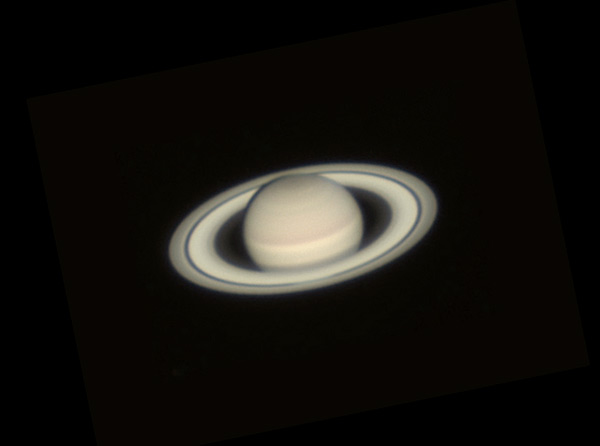
Friday, August 3
• This week four bright planets shine at once during twilight, if you have low horizons in the right places. From right to left, they're Venus low in the west, Jupiter higher in the southwest, Saturn at about the same height in the south-southeast, and brilliant Mars low in the southeast. Best view: about 45 to 60 minutes after sunset.
• Action in Sagittarius. Less than 3° to the lower right of Saturn this week lies M8, the Lagoon Nebula and its associated star cluster. The Lagoon is the brightest emission nebula of the summer skies. In a dark sky it's obvious to the naked eye as a small Milky Way patch if you know where to look: above the spout of the Sagittarius Teapot.
Above M8 by 1.4°, and a bit to the right, is fainter M20, the Trifid Nebula and its adjacent cluster M21. This nebula generally needs a telescope.
But there's more! Matt Wedel, in his Binocular Highlight column in the August Sky & Telescope (page 43), calls attention to two other binocular clusters in the same field. They're sparse and subtle but easy to recognize once you know them. Collinder 367 is located 1.3° east-northeast of the Lagoon. ASCC 93 is the same distance east-northeast of the Trifid. Saturn is currently almost stepping on them.
"I can't help but see four objects in a parallelogram now," Wedel writes about the binocular view. "In the northwest corner, M20, M21, and a group of bright stars between them all merge together onto a bright glow that rivals M8, which occupies the southwest corner. To the east, Cr 367 and ASCC 93 seem like smaller, fainter echoes of their nebular neighbors." The things you didn't know!
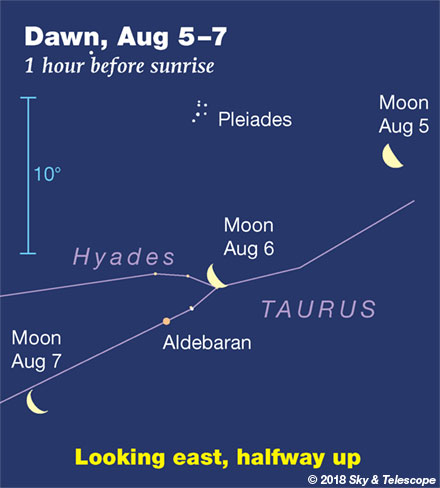
Saturday, August 4
• Last-quarter Moon (exact at 2:18 p.m. Eastern Daylight Time). The Moon rises as late as 2 a.m. tonight, depending on your location. Once it's well up, spot the Pleiades to its left and Aldebaran below the Pleiades. As the very first light of dawn hints at the coming day, you'll find Orion clearing the eastern horizon far below Aldebaran (for mid-northern skywatchers).
Sunday, August 5
• The Big Dipper hangs diagonally in the northwest at nightfall. From its midpoint, look three fists at arm's length to the right to find Polaris (not very bright) glimmering due north as always.
Polaris is the handle-end of the Little Dipper. The only other parts of the Little Dipper that are even modestly bright are the two stars forming the outer end of its bowl: Kochab and Pherkad. On August evenings you'll find them to Polaris's upper left (by about a fist and a half at arm's length). They're called the Guardians of the Pole, since they circle endlessly around Polaris throughout the night and throughout the year.
Monday, August 6
• The tail of Scorpius, rich in binocular sights, is low in the south right after dark, well to the lower right of Saturn. How low it is depends on how far north or south you live: the farther south, the higher.
Look for the two stars especially close together in the tail. These are Lambda and fainter Upsilon Scorpii, known as the Cat's Eyes. They're canted at an angle; the cat is tilting his head and winking.
The Cat's Eyes point west (right) by nearly a fist-width toward Mu Scorpii, a much tighter pair known as the Little Cat's Eyes. They're oriented almost exactly the same way as the big Cat's Eyes. Can you resolve the Mu pair without using binoculars?
Tuesday, August 7
• Venus, Jupiter, and Mars currently outshine them, but the two brightest stars of summer are Vega, overhead shortly after nightfall, and Arcturus, shining in the west.
Draw a line down from Vega to Arcturus. A third of the way down, the line crosses the dim Keystone of Hercules. Two thirds of the way down it crosses the dim semicircle of Corona Borealis with its one modestly bright star, Alphecca or Gemma.
Vega and the Keystone's star closest to it form an equilateral triangle with Eltanin, the nose of Draco the Dragon, to their north. Eltanin is the brightest star of Draco's quadrilateral head. He's eternally eyeing Vega.
Wednesday, August 8
• With the advance of summer the Sagittarius Teapot, now moving into the south after dark, is starting to tilt and pour from its spout to the right. Saturn stands above the spout. The Teapot will tilt farther and farther for the rest of the summer — or for much of the night if you stay out late.
Thursday, August 9
• Bright Vega passes closest to overhead soon after dark now. How closely it misses your zenith depends on how far north or south you are. It passes right through your zenith if you're at latitude 39° north (Washington DC, Cincinnati, Kansas City, Lake Tahoe). How closely can you judge this by looking?
Then Deneb crosses closest to the zenith almost exactly two hours after Vega.
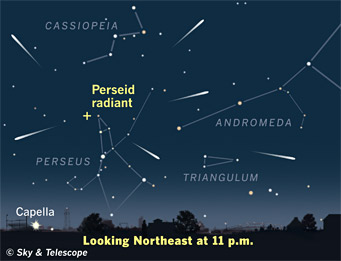
Friday, August 10
• It's Perseid weekend! The annual Perseid meteor shower should come to its peak late Sunday night August 12th. Already the meteors are increasing in number. You may have noticed a few early Perseids as early as a week or two ago.
Conditions are ideal this year. There's no moonlight, and the shower's predicted maximum comes during nighttime for Europe and North America on the night of August 12–13.
Whatever the night you'll see the most meteors when the shower's radiant is high: from about midnight to dawn. On peak night you may see one or two meteors a minute on average during this time if your sky is very dark. There will be fewer in the evening, but the ones you do see when the radiant is low will be "Earthgrazers" skimming the upper atmosphere in long, graceful flight paths.
For more see the August Sky & Telescope, page 48, or check SkyandTelescope.com as the date approaches.
Saturday, August 11
• The W of Cassiopeia, tilted not very much, is up in the northeast these evenings above Perseus. The upper, right-hand side of the W is the brightest. Watch Cas rise higher and tilt further through the night and through the next few months.
• New Moon (exact at 5:58 a.m. EDT August 11th).
________________________
Want to become a better astronomer? Learn your way around the constellations! They're the key to locating everything fainter and deeper to hunt with binoculars or a telescope.
This is an outdoor nature hobby. For an easy-to-use constellation guide covering the whole evening sky, use the big monthly map in the center of each issue of Sky & Telescope, the essential guide to astronomy.

Once you get a telescope, to put it to good use you'll need a detailed, large-scale sky atlas (set of charts). The basic standard is the Pocket Sky Atlas (in either the original or Jumbo Edition), which shows stars to magnitude 7.6.
Next up is the larger and deeper Sky Atlas 2000.0, plotting stars to magnitude 8.5; nearly three times as many. The next up, once you know your way around, are the even larger Interstellarum atlas (stars to magnitude 9.5) and Uranometria 2000.0 (stars to magnitude 9.75). And read how to use sky charts with a telescope.
You'll also want a good deep-sky guidebook, such as Sue French's Deep-Sky Wonders collection (which includes its own charts), Sky Atlas 2000.0 Companion by Strong and Sinnott, or the bigger Night Sky Observer's Guide by Kepple and Sanner.
Can a computerized telescope replace charts? Not for beginners, I don't think, and not on mounts and tripods that are less than top-quality mechanically (meaning heavy and expensive). And as Terence Dickinson and Alan Dyer say in their Backyard Astronomer's Guide, "A full appreciation of the universe cannot come without developing the skills to find things in the sky and understanding how the sky works. This knowledge comes only by spending time under the stars with star maps in hand."
This Week's Planet Roundup
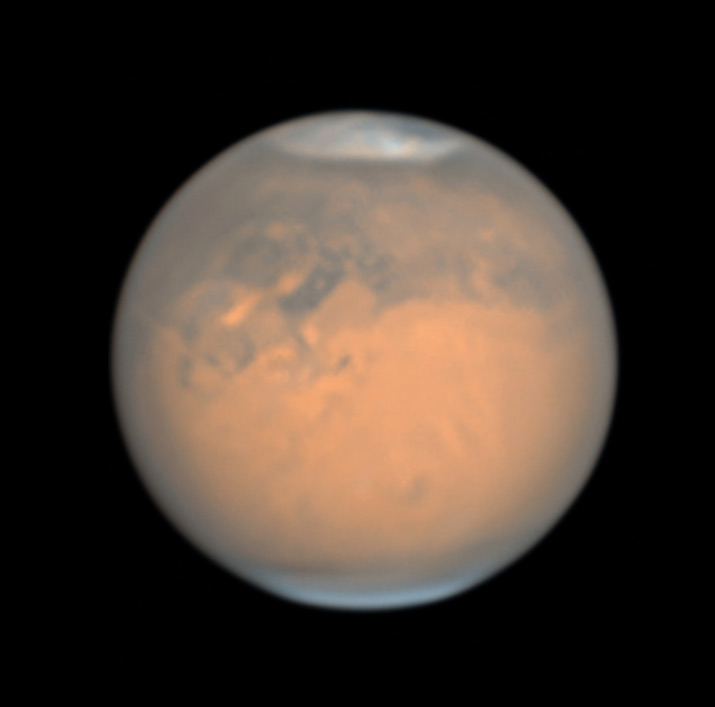
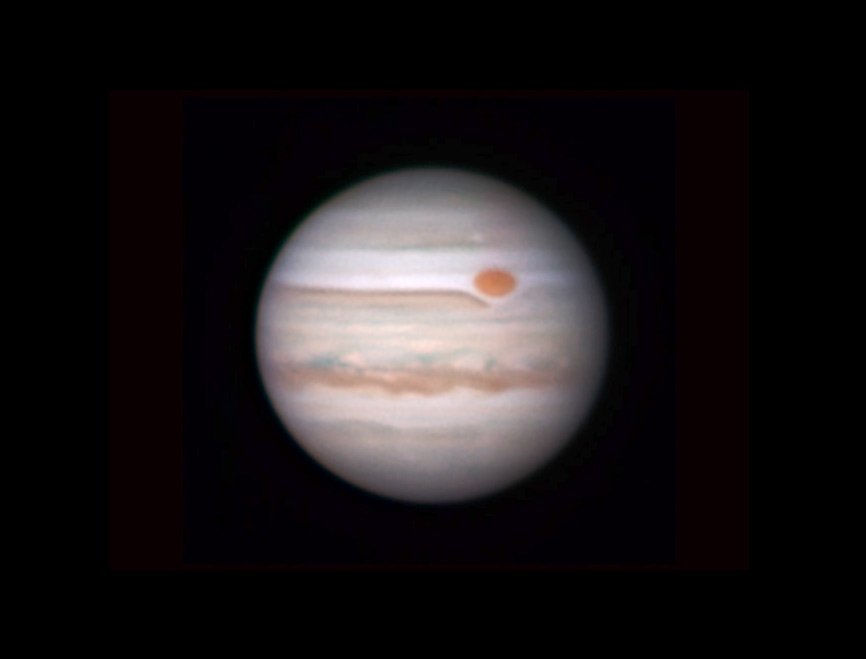
Mercury is hidden in conjunction with the Sun.
Venus (magnitude –4.3) shines low in the west during twilight, a little lower every week. It now sets around the end of twilight.
In a telescope Venus has waned almost to dichotomy (half lit) and has grown to 21 or 22 arcseconds tall. For the best telescopic seeing catch Venus as early as you can, preferably long before sunset.
Mars all week is still essentially as big and bright (magnitude –2.8) as when it was exactly at its closest (in 15 years!) on July 30th. It's the firespot blazing yellow-orange in the southeast during evening. Mars is highest in the south around midnight daylight-saving time, though it's not very high for us mid-northern observers; it's at a southerly declination (–26°) in southern Capricornus.
Mars is still 24 arcseconds wide. The dust in its atmosphere continues to thin gradually, allowing faint, low-contrast views of some dark surface markings.
Can you identify any of these features? For a Mars map that shows which ones are facing Earth at your time and date, use our Mars Profiler.
Jupiter (magnitude –2.1, in Libra) shines in the southwest in twilight. It's between Spica about 20° to its lower right and the head of Scorpius about 20° to its left. Jupiter is at quadrature this week, 90° east of the Sun.
Saturn (magnitude +0.1, above the spout of the Sagittarius Teapot) glows yellow in the south after dark, about 30° to the right or upper right of much brighter Mars. In a telescope Saturn's rings are still tilted 26° to our line of night, nearly as open as we ever see them.
Uranus (magnitude 5.8, at the Aries-Pisces border) and Neptune (magnitude 7.8, in Aquarius) are well up in the east and southeast, respectively, after about 1 a.m. Finder charts for Uranus and Neptune.
______________________
All descriptions that relate to your horizon — including the words up, down, right, and left — are written for the world's mid-northern latitudes. Descriptions that also depend on longitude (mainly Moon positions) are for North America.
Eastern Daylight Time (EDT) is Universal Time (also called UT, UTC, GMT, or Z time) minus 4 hours.
______________________
"Remember to look up at the stars and not down at your feet. Try to make sense of what you see and wonder about what makes the universe exist. Be curious."
— Stephen Hawking, 1942–2018
______________________
"The dangers of not thinking clearly are much greater now than ever before. It's not that there's something new in our way of thinking, it's that credulous and confused thinking can be much more lethal in ways it was never before."
— Carl Sagan, 1996
______________________
"Objective reality exists. Facts are often determinable. Vaccines save lives. Carbon dioxide warms the globe. Bacteria evolve to thwart antibiotics, because evolution. Science and reason are not a political conspiracy. They are how we determine facts. Civilization's survival depends on our ability, and willingness, to do this."
— Alan MacRobert, your Sky at a Glance editor
______________________
"Facts are stubborn things."
— John Adams, 1770
 0
0








Comments
You must be logged in to post a comment.